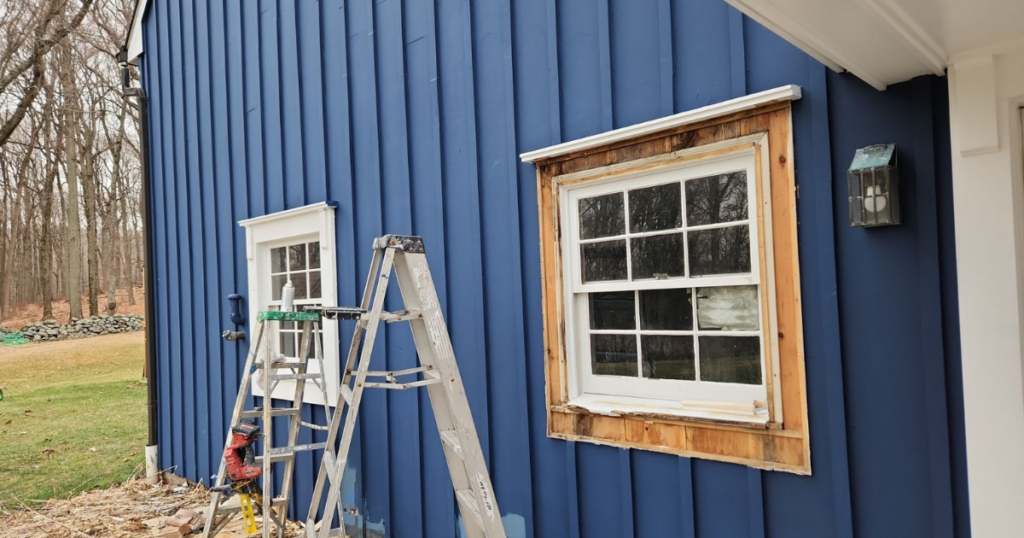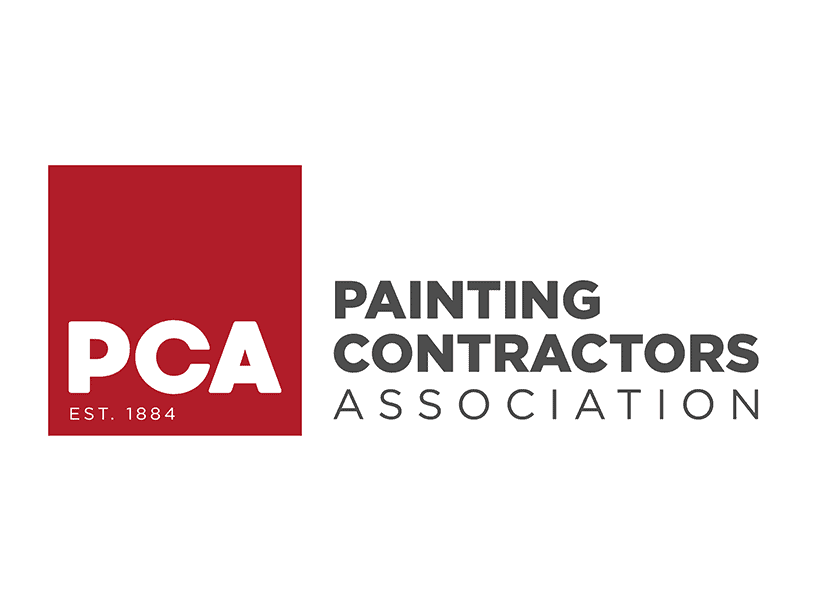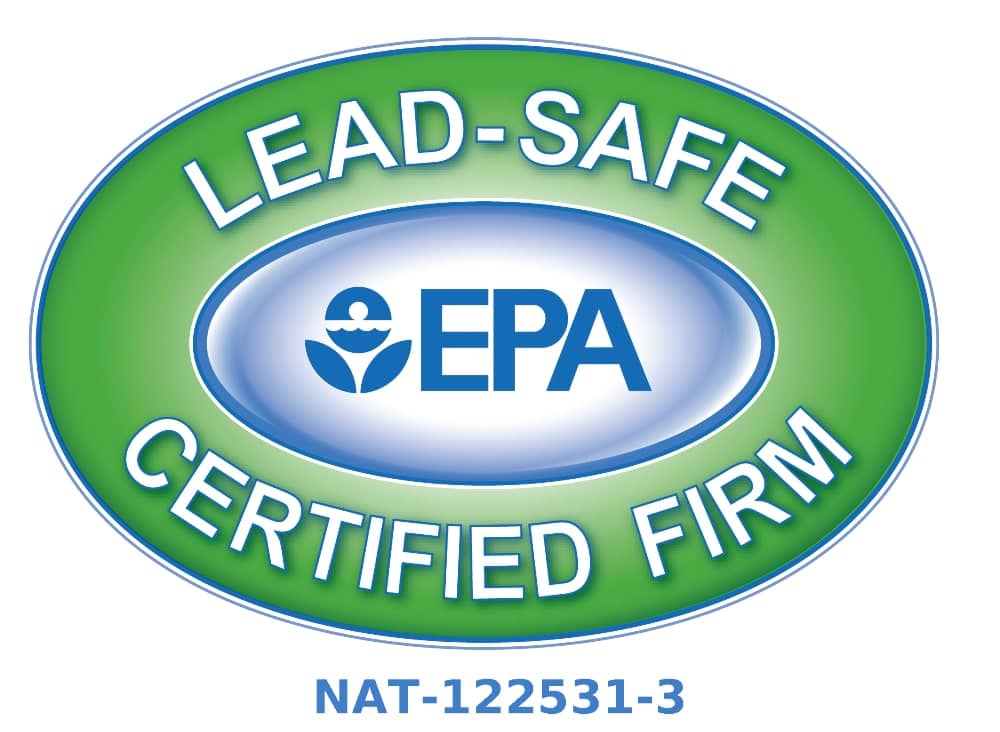
05 Aug How Exterior Painting Protects Your Home from the Elements
Painting your home’s exterior forms a protective barrier that helps shield your property from moisture, relentless UV rays, and damaging temperature swings. By sealing gaps and using premium, UV-resistant coatings, you reduce the risk of rot, fading, and cracking while extending the life of siding and trim. If you want expert application and durable results, Home Works Painting can assess your needs and recommend the right products for lasting protection.
Key Takeaways:
- Moisture protection: Quality exterior paint seals surfaces to block water infiltration, reducing the risk of mold, mildew, and wood rot—especially helpful during sudden rains and humid conditions.
- Sun and temperature defense: UV-resistant and reflective coatings resist fading and heat absorption, while flexible paints accommodate expansion and contraction to prevent cracking and peeling.
- Long-term value and professional application: Investing in premium paints and expert installation extends your home’s lifespan, lowers maintenance costs, and preserves curb appeal—reach out to Home Works Painting at https://homeworkspainting.com/ for exterior painting services.
Moisture Management: The Essential Barrier Against Water Intrusion
Understanding Water Damage and Its Impact
Moisture can trigger mold growth within 24–48 hours on damp surfaces and start wood rot that gradually compromises framing and trim. You’ll see staining, blistering paint, and soft spots long before hidden structural damage appears, and water-related repairs can quickly reach into the thousands. In Arizona’s monsoon season, even brief roof or siding breaches let significant moisture into cavities, so spotting early signs and addressing them limits long-term, expensive remediation.
Effective Sealing Strategies Through Exterior Painting
Sealing begins with proper surface prep: pressure-wash, dry, then replace rotten wood and use a high-quality polyurethane or silicone caulk on gaps and joints. Apply a primer to bare surfaces, then a two-coat topcoat of 100% acrylic latex or an elastomeric coating to form a continuous, water-resistant barrier; elastomerics can bridge hairline cracks up to 1/8 inch and resist ponding better than standard paints.
For best results, you should use a system approach: backer rod for gaps over 1/4″, premium caulk (typical service life 10–20 years) in butt joints, oil- or shellac-based primers on tannin-rich wood, and two finish coats of high-quality exterior acrylic. Apply coatings only after moisture readings show substrate below 12–15% to avoid trapped moisture. That sequence—repair, backer rod/caulk, primer, two finish coats—reduces penetration points, limits freeze/thaw or expansion/contraction stress, and can extend repaint intervals from typical 5 years to 10+ years on many surfaces, saving you both time and money over a decade.
UV Protection: Preserving your Home’s Aesthetic and Structure
The Dangers of Prolonged Sun Exposure
Arizona exposure—often more than 300 sunny days per year in many areas—accelerates paint breakdown: fading, surface cracking, and wood drying that leads to faster deterioration. Low-quality coatings can lose color and protective binders within 2–5 years, increasing repair costs and weakening siding, trim, and fascia. You’ll notice chalking, loss of gloss, and micro-cracks long before structural problems appear, so addressing UV damage early preserves both curb appeal and underlying materials.
Advanced Paint Formulations for UV Resistance
Modern exterior paints use UV absorbers, acrylic resins, and reflective pigments to slow degradation and maintain color retention; premium 100% acrylic formulations typically outperform basic latex, often lasting 8–12 years in harsh sun when properly applied. Ceramic microspheres and infrared-reflective additives lower surface temperatures, helping materials expand less and resist premature failure in intense heat.
- UV absorbers and stabilizers for pigment protection
- Reflective/infrared pigments to reduce surface heat gain
- 100% acrylic binders for long-term adhesion and flexibility
- Ceramic additives to enhance durability and abrasion resistance
- Mildewcides and water-repellent agents for combined UV and moisture defense
Key UV-Resistant Features
| Feature | Benefit |
| UV absorbers & stabilizers | Protect pigments and binders from breakdown, extending color life |
| Reflective pigments | Lower surface temps, reduce thermal stress and fading |
| 100% acrylic resins | Maintain flexibility through heat cycles, reduce cracking |
| Ceramic microspheres | Improve toughness and abrasion resistance in high-sun environments |
Surface preparation and correct film thickness matter as much as the formulation: proper priming, filling gaps, and applying the manufacturer’s recommended mil-rate can add 2–5 years to overall performance. You’ll get the best results when coatings are applied under recommended temperature and humidity ranges and when professional techniques—spray plus back-rolling or brush-on trim—ensure uniform coverage.
- Inspect exteriors annually (look for chalking, cracks, color loss)
- Wash surfaces once a year to remove UV-damaged chalk and grit
- Plan for touch-ups at first signs of cracking; full recoats every 8–12 years for premium systems
- Choose lighter, reflective colors on south- and west-facing walls to cut heat load
Maintenance & Performance
| Item | Recommendation |
| Inspection frequency | Annually, after the monsoon season or heatwaves |
| Cleaning | Soft wash yearly to remove chalk and pollutants |
| Recoat interval | Premium 100% acrylic: 8–12 years; economy: 3–5 years |
| Color strategy | Use reflective/light shades on high-sun exposures to reduce thermal stress |
Temperature Resilience: Safeguarding Against Extremes
Temperature Resilience Snapshot
| Risk | How the Right Paint Helps |
| Daily expansion/contraction (desert swings often 30–40°F) | Flexible coatings absorb movement, preventing cracks and peeling |
| Prolonged high heat (surface temps regularly >120°F) | UV-stable pigments and reflective additives reduce fading and heat absorption |
| Freeze-thaw cycles in cooler climates | Breathable, elastic paints shed moisture and resist spalling |
The Effects of Heat and Cold on Building Materials
Repeated temperature swings force siding, wood trim, and stucco to expand and contract, which over time produces hairline cracks, delamination, and paint failure. In Arizona, you can see daytime highs above 110°F and nights 30–40°F cooler, accelerating fatigue in substrates and coatings. Metal fasteners can loosen, and untreated wood can split or check, creating entry points for moisture and pests that raise repair costs.
Choosing Paints Designed for Temperature Fluctuation
Look for 100% acrylic or elastomeric formulations with high elongation ratings (typically 200–500%) and strong adhesion; these allow the coating to stretch with your home’s materials without cracking. Pigment selection matters too: lighter, reflective colors lower surface temperatures and reduce thermal stress, while mildew-resistant additives improve long-term performance in humid bursts during monsoon season.
Choosing Paints — Key Selection Criteria
| Property | What you should require |
| Flexibility / Elongation | Elastomeric or high-elastomer acrylics rated 200–500% to bridge cracks |
| UV and Heat Resistance | UV blockers and reflective pigments to minimize fading and heat build-up |
| Breathability | Moderate vapor permeability to let trapped moisture escape without allowing water in |
| Substrate match | Masonry-specific coatings for stucco, flexible acrylics for wood, specialty primers for metal |
| Application window | Products that can be applied at high ambient temperatures and have appropriate recoat times |
The Economic Advantages of Quality Paint
Long-Term Cost Benefits of Investing in Premium Paint
Premium exterior paints typically last 10–15 years versus 3–5 years for low-end options, so your repaint cycle can be cut from every 5 years to once a decade or more. For a 2,000 sq ft home, repainting can run roughly $6,000–$12,000; choosing longer‑lasting coatings can halve your lifetime maintenance and repair expenses by reducing the frequency of repainting and avoiding moisture or UV-related repairs.
The Role of Professional Application in Durability
Surface preparation and application technique determine how long a coating performs: pressure washing, scraping, patching, and a quality primer often add 5–10 years to a finish. Improper preparation or thin application can lead to premature peeling, blistering, and the need for costly spot repairs within 1–3 years, rather than a decade.
Detailed prep includes testing for adhesion, replacing damaged siding or trim, filling gaps with backer rod and elastomeric sealants, and using a stain‑blocking primer on tannin‑rich woods. Professionals control dry film thickness—typically 2–4 mils per coat for acrylics—and match coatings to substrate and climate (for Arizona, elastomeric or high‑flex acrylics resist thermal cycling). Proper equipment—airless sprayers for uniform coverage plus expert back‑rolling—ensures consistent film build; many contractors provide documented warranties and life‑cycle estimates so you can compare actual long‑term value. Home Works Painting follows these standards to help protect your investment (https://homeworkspainting.com/).
Aesthetic Appeal: Enhancing Curb Appeal Through Color
The Psychological Effects of Color on Homeowners and Passersby
Color directs how people perceive your home: deep navy or charcoal communicates formality and permanence, while warm beiges and soft greens create a welcoming, restful vibe. You can use the 60/30/10 rule—primary wall color 60%, secondary 30%, accent 10%—to balance impact without overwhelming the eye. Keep in mind that very dark colors absorb heat and can accelerate exterior wear, so weigh aesthetic goals against thermal and maintenance effects.
Trends in Exterior Color Choices and Their Longevity
Current palettes favor warm neutrals (greige, warm white), earthy greens, and saturated accents like deep blue or terra cotta; these choices pair well with modern trim contrasts and natural landscaping. Neutral schemes generally show less visible fading over time, while vivid hues demand higher-grade, UV-resistant pigments. Look at manufacturer warranties—many premium 100% acrylic exterior paints offer 10–15 year performance guarantees—and consult the paint’s LRV (Light Reflectance Value) when assessing heat absorption and longevity.
Test samples on each elevation before committing: apply 2–3 square-foot swatches, observe them at noon and dusk over several weeks, and note how color shifts in direct sun versus shaded areas. For Arizona exteriors, selecting colors with an LRV above about 40–50 for large wall surfaces helps reduce surface temperatures, while reserving low-LRV shades for trim or accents minimizes heat-related expansion. Prioritize paints with documented UV inhibitors and a solid warranty, and document sample performance to avoid costly repainting down the line.
Maintenance Considerations: Protecting Your Investment
Regular Maintenance Tips to Extend Paint Life
Inspect your exterior at least once a year and after monsoon storms for peeling, cracking, or water stains. Wash surfaces with a mild detergent every 6 months to remove grit and UV-damaged chalk. Keep shrubs trimmed at least 6 inches from siding, and repair caulked joints within 48–72 hours of noticing gaps. Replace rotted wood immediately and touch up chips before they spread to prevent moisture intrusion.
- exterior painting
- moisture protection
- UV resistance
- paint longevity
Perceiving the most minor failures early prevents costly structural repairs.
Recognizing When It’s Time for a Refresh
Spotting fading, heavy chalking (rub your thumb across painted siding; if a thick powder appears), widespread peeling, or cracking in more than 25–30% of a surface signals you should plan a repaint. Typical paint lifespans range from 5–7 years in high-UV regions to 10–15 years for premium formulations; shorter lifespans often indicate substrate or moisture problems that need addressing before new paint is applied.
Perform a quick checklist: probe trim and soffits for soft spots, look behind downspouts for water stains, and inspect flashing around windows. If you find mold or mildew, treat it with a biocide and verify the source of moisture before repainting—simply coating over contamination leads to failure within months. For stucco, consider an elastomeric coating; for wood, a high-quality 100% acrylic exterior system with proper priming will extend service life. Hire professionals for elevations above 12 feet or when structural repairs are needed so your repainting investment delivers maximum protection.
Choosing the Right Professionals: The Importance of Expertise
What to Look for in a Professional Painting Service
Verify licensing and insurance, request a written estimate that lists prep steps, products, and labor, and ask for an explicit warranty (many premium jobs carry 5–10 year workmanship guarantees). Inspect before-and-after photos and at least three local references to confirm the crew uses recommended products, such as acrylic latex with UV blockers or elastomeric coatings for stucco. Also, ensure that surface prep (power washing, caulking, priming) is included in the contract.
The Value of Local Knowledge in Harsh Climates
Contractors familiar with Arizona’s weather know to schedule work outside the June–September monsoon window and avoid painting when daytime highs exceed 95–100°F. Expect them to specify products with UV blockers and reflective pigments, and to recommend flexible coatings that tolerate daily thermal expansion. Local expertise also means knowing application windows—optimal curing often occurs between 50–85°F—so your paint bonds correctly and reaches the 10–15 year lifespan premium coatings promise.
Local teams will tailor prep and materials: pressure washing at 1,500–2,000 psi for dirt and efflorescence removal, using polyurethane or silicone caulks at joints to prevent water intrusion, and choosing primers engineered for high UV and alkaline substrates like new stucco. You should get a timeline that avoids upcoming storms and allows 24–48 hours of dry weather for initial cure; that attention to detail reduces peeling, fading, and costly callbacks. For home services in the region, Home Works Painting at https://homeworkspainting.com/ can provide estimates based on these local standards.
Summing up
Now you can protect your home from moisture, sun, and temperature swings with high-quality exterior paint that seals surfaces, blocks UV, and flexes with expansion and contraction. By choosing premium products and professional application, you reduce maintenance, extend your siding’s life, and preserve curb appeal. For dependable, long-lasting results tailored to your climate, trust Home Works Painting to provide expert coatings and workmanship that keep your home secure and attractive year after year.
FAQ
Q: How does exterior painting prevent moisture and water damage to my home?
A: A high-quality exterior paint system forms a tight, water-resistant barrier that limits moisture penetration into siding, trim, and wood components. Proper surface preparation (cleaning, scraping, and priming), sealing gaps with caulk, and using breathable yet water-repellent coatings all help stop water from seeping into vulnerable joints and porous materials. For climates with seasonal storms or sudden downpours, selecting products formulated for moisture resistance and ensuring professional application reduces the risk of mold, mildew, rot, and the costly structural repairs that follow. For expert assessment and moisture-control paint systems, Home Works Painting can evaluate your exterior and recommend appropriate primers and topcoats — https://homeworkspainting.com/.
Q: In what ways does exterior paint protect against sun and UV damage?
A: Modern exterior paints include UV absorbers and reflective pigments that slow fading, prevent chalking, and reduce heat absorption on surfaces. These additives help maintain color vibrancy and prevent the drying, cracking, and degradation of wood and other materials caused by prolonged sun exposure. Lighter colors and specialty reflective coatings can further lower surface temperatures, reducing thermal stress. Choosing UV-resistant formulations and proper finish levels (e.g., satin or semi-gloss for trim and trim details) extends aesthetic life and structural performance. Home Works Painting can recommend UV-stable color systems and finishes suited to your location and exposure — see https://homeworkspainting.com/ for examples and consultations.
Q: How does investing in quality paint and professional application save money over time?
A: Higher-grade coatings and skilled application provide durability, flexibility, and adhesion that reduce cracking, peeling, and premature failure. That longevity means fewer repaints, fewer repairs from moisture or sun damage, and lower long-term maintenance costs. Professional preparation—repairing damaged substrate, using appropriate primers, and applying correct coverage—ensures coatings perform as designed and deliver the advertised lifespan. In addition, experts can recommend warranties, product combinations, and maintenance schedules that maximize return on investment. For a written estimate and guidance on cost-effective, long-lasting exterior paint strategies, contact Home Works Painting at https://homeworkspainting.com/.

Mike Katounas is the owner of Home Works Painting, a painting business in Northern Virginia. He has over 15 years of experience in residential interior and exterior painting, drywall installation/repair, carpentry, wallpaper removal, power washing, commercial painting, color consultation, and staining/sealing. Their service areas include Chantilly, Fairfax, Herndon, Oakton, Reston. Mike takes pride in his work, and he always follows a strict code of conduct that includes the use of quality paint, a clean workspace, and an honest, respectful approach to his customers.












Sorry, the comment form is closed at this time.